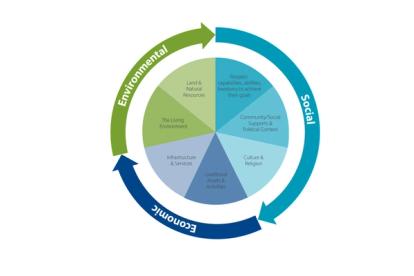
Developing Criteria to Measure Social Mine Closure Outcomes
- Post Date
- 08 March 2023
- Read Time
- 4 minutes

The following Insight is compiled with information from a research paper prepared for the ACG Mine Closure 2022 conference. It was authored by Jessica Edwards, SLR Consulting Ltd., Vidette Bester, SRK Consulting, and Ashleigh Maritz, SRK Consulting. Download the full technical paper here.
Current thinking on what constitutes successful mine closure has come a long way in recent years. This includes careful consideration in creating a sustainable and positive post mining legacy.
Clear and measurable mine closure criteria are a recognised prerequisite for successful and sustainable closure of mine sites. However, too many mines struggle to conceptualize social mine closure criteria for their operations.
Closing a Mine Properly
Within a development context, mines that close without proper social transitioning plans in place could negatively affect the surrounding communities and the wider social economic context of the region.
Recently, we have seen two such examples in South Africa, one was the abrupt closure of the Blyvooruitzicht Gold Mine in Carletonville where thousands of people lost their jobs overnight, creating an instantaneous social and economic hardship for the affected communities.
The second is the very recent failure of the Jagersfontein Tailing Storage Facility which highlighted the potential health and safety impacts, and the associated loss of livelihood assets and activities communities can face if mines are not properly closed and rehabilitated.
Scores of unrehabilitated and abandoned mines, including those in care and maintenance, have not effectively addressed their environmental and social risks and impacts, heightening the need to focus on mine closure policy and regulation.
Proposing a Clear Framework to Develop Social Mine Closure Criteria
Many mines lack a clear framework to determine social mine closure criteria. We found that the framework from Vanclay & Smith (2017) provides a valuable base for elaborating on and applying a social lens in the development of mine closure criteria.

Social, economic and environmental aspects that should inform mine closure criteria. Adapted from Vanclay and Smyth (2017)
By ensuring that mine closure plans also focus on social aspects, such as the way in which communities currently rely on land and natural resources, we can limit additional impacts on the quality of their living environment and strive to improve them.
We can also plan to reduce impacts on their livelihood assets and activities and ensure continued access to services and facilities currently provided by the mine.
By proactively investing in programmes that build people’s capacities, abilities, and freedoms to achieve their goals, many of the negative impacts associated with retrenchment can be mitigated.
The key to unlocking successful programmes is to start early and to either collaborate with, or to build the capacity of, existing institutions. This approach allows mines to refine their closure vision and to better incorporate stakeholder requirements into their plans for final landform design.
Planning for Social Mine Closure
Planning for mine closure starts at a project’s inception. It is recognised that a closure plan may start out as hypothetical, but there is plenty of opportunity to refine it as closure approaches.
Since closure planning spans the life cycle of the mine, and assuming it is included in the regular updates to the life of mine planning and scheduling, the level of uncertainty reduces as closure becomes more of a reality. This helps ensure that mines are prepared for unexpected closure in the event of unplanned events like changes in markets, or other unforeseen events.
A Closer Look at Social Mine Closure Criteria
Social mine closure criteria are requirements that, if met, conveys the success of the closure activities in meeting closure objectives. When the above framework is used, social criteria can be developed that state, for example, that a Closure Environmental, Social and Health Impact Assessment has been conducted to inform closure mitigation measures.
Social closure criteria can also denote that closure messaging, including communication channels and timing, was properly designed, and that meaningful engagement took place with local, regional and national stakeholders. By tracking the successful outcome of these criteria, mines will be better placed to address their mine closure objectives.
It is imperative to integrate social mechanisms for closure into closure planning as early as possible. A regular review of social mine closure objectives and criteria should be undertaken and updated with each iteration of the closure plan. Experience has shown that a collaborative framework for engagement is important when considering a post-mining landscape and socio-economic reality.
By developing a closure vision with stakeholders, it is possible to home in a set of acceptable mine closure criteria, and ultimately, achieve stakeholder aligned closure outcomes.
If you have any enquiries or questions regarding mine closure, please feel free to contact us, where you can talk to one of our experts.
Recent posts
-

-

Navigating the evolving landscape of corporate sustainability and communications in the US
by Chynna Pickens
View post -
